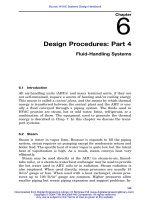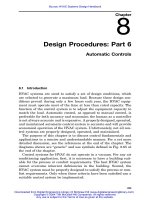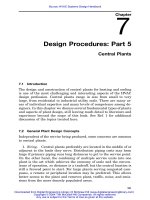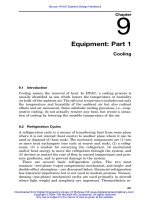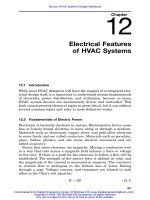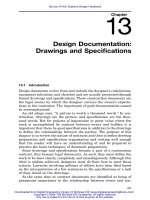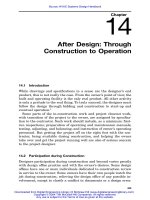Tài liệu HVAC Systems Design Handbook part 5 docx
Bạn đang xem bản rút gọn của tài liệu. Xem và tải ngay bản đầy đủ của tài liệu tại đây (649.67 KB, 50 trang )
95
Chapter
5
Design Procedures: Part 3
Air-Handling Systems
5.1 Introduction
In most HVAC systems, the final energy transport medium is moist
air—a mixture of dry air and water vapor. This is conveyed through
filters, heat exchange equipment, ducts, and various terminal devices
to the space to be air-conditioned. The power to move the air is sup-
plied by fans. This chapter discusses fans and duct systems, together
with related subjects such as grilles, registers, diffusers, dampers, fil-
ters, and noise control.
5.2 Fans
According to Air Moving and Conditioning Association (AMCA) Stan-
dard 210,
1
‘‘A fan is a device for moving air which utilizes a power-
driven, rotating impeller.’’ The three fan types of primary interest in
HVAC systems are centrifugal, axial, and propeller. The fan motor
may be directly connected to the impeller, directly connected through
a gearbox, or indirectly connected by means of a belt-drive system.
5.2.1 Fan law equations
The fan law equations are used to predict the performance of a fan at
some other condition than that at which it is tested and rated. The
HVAC designer is particularly interested in the effects on horsepower,
pressure, and volume consequent to varying the speed of the fan in a
system.
Source: HVAC Systems Design Handbook
Downloaded from Digital Engineering Library @ McGraw-Hill (www.digitalengineeringlibrary.com)
Copyright © 2004 The McGraw-Hill Companies. All rights reserved.
Any use is subject to the Terms of Use as given at the website.
96 Chapter Five
The fan laws expressed in the following equations relate only to the
effect of varying speed, assuming that fan size and air density remain
constant.
RPM
2
CFM ϭ CFM (5.1)
21
RPM
1
2
RPM
2
SP ϭ SP (5.2)
ͩͪ
21
RPM
1
2
RPM
2
TP ϭ TP (5.3)
ͩͪ
21
RPM
1
3
RPM
2
BHP ϭ BHP (5.4)
ͩͪ
21
RPM
1
3
where CFM ϭ airflow rate, ft / min
SP ϭ static pressure
TP ϭ total pressure
BHP ϭ brake horsepower, bhp
Expressed in simple language, the fan laws say that when fan size
and air density are unchanged, the airflow rate varies directly as the
change in speed, the pressure developed by the fan varies as the
square of the change in speed, and the power required to drive the
fan varies as the cube of the change in speed.
The complete fan laws also include terms for changes in fan size
and air density. The laws are valid only when fans of different sizes
(diameters) are geometrically similar.
3
CFM RPM D
222
ϭϫ (5.5)
ͩͪ
CFM RPM D
111
22
TP SP VP RPM Dd
22 2 222
ϭϭ ϭ (5.6)
ͩͪͩͪ
TP SP VP RPM Dd
11 1 111
35
BHP RPM Dd
2222
ϭ ⅐ (5.7)
ͩͪͩͪ
BHP RPM Dd
1111
where D ϭ fan diameter and d ϭ air density.
For further variations, see ASHRAE Handbook, 2000 HVAC Systems
and Equipment, Chap. 18, Table 2, p. 18.4.
Design Procedures: Part 3
Downloaded from Digital Engineering Library @ McGraw-Hill (www.digitalengineeringlibrary.com)
Copyright © 2004 The McGraw-Hill Companies. All rights reserved.
Any use is subject to the Terms of Use as given at the website.
Design Procedures: Part 3 97
Figure 5.1 Principle of operation of centrifugal fan.
Figure 5.2 Cutaway view of centrifugal fan.
5.2.2 Centrifugal fans
A centrifugal fan creates pressure and air movement by a combination
of centrifugal (radial) velocity and rotating (tangential) velocity. As
shown in Fig. 5.1, these two effects combine to create a net velocity
vector. When the fan is enclosed in a scroll (housing) as shown in Fig.
5.2, some of the velocity pressure is converted to static pressure. The
fan characteristics can be changed by changing the shape of the blade.
Typical shapes (Fig. 5.3) are forward-curved, straight radial, back-
ward-inclined (straight or curved), and airfoil.
Design Procedures: Part 3
Downloaded from Digital Engineering Library @ McGraw-Hill (www.digitalengineeringlibrary.com)
Copyright © 2004 The McGraw-Hill Companies. All rights reserved.
Any use is subject to the Terms of Use as given at the website.
98 Chapter Five
Figure 5.3 Centrifugal fan blade types. A. Forward curved. B. Radial. C. Backward-
inclined. D. Airfoil.
The geometry of the fan wheel, inlet cone, and scroll also has an
effect on fan performance and efficiency. Figure 5.4 shows a typical
cross section for a backward-inclined (BI) or airfoil (AF) fan wheel.
For a given wheel or diameter, as the blade gets narrower and longer,
higher pressures can be generated but flow rates are reduced. The
inlet cone is shown curved (bell-mouth) to minimize air turbulence.
Straight cones are also used, at the cost of some reduction in perform-
ance. The clearance between the inlet cone and the wheel shroud must
be minimized for efficiency, because some air is bypassed through this
opening. The forward-curved (FC) wheel (Fig. 5.5) usually has a short,
wide blade and a flat shroud. The inlet cone is curved or tapered and
is mounted to minimize the clearance between the inlet cone and
shroud. This type of fan handles large air volumes at low pressures.
The illustrations show single-width, single-inlet (SWSI) fans. Double-
width, double-inlet (DWDI) fans are also made.
5.2.3 Fan testing procedures
Fans for HVAC applications should be tested and certified for perform-
ance rating in accordance with AMCA Standard 210,
1
promulgated by
the Air Moving and Conditioning Association. Also, ASHRAE Stan-
dard 51 prescribes the test setup and data-gathering procedures for
fan testing. For a line of several sizes of geometrically similar fans,
Design Procedures: Part 3
Downloaded from Digital Engineering Library @ McGraw-Hill (www.digitalengineeringlibrary.com)
Copyright © 2004 The McGraw-Hill Companies. All rights reserved.
Any use is subject to the Terms of Use as given at the website.
Design Procedures: Part 3 99
Figure 5.4 Cross section of BI, radial, or airfoil fan.
Figure 5.5 Cross section of FC fan.
only the smallest fan in the line is actually tested. Performance of all
other sizes is calculated, by using formulas based on the fan laws. The
testing setup and procedures are designed for ideal inlet and outlet
conditions, with a minimum of turbulence. Later in this chapter we
discuss the effect of the nonideal conditions usually found in HVAC
system installations.
The test procedure includes measuring the airflow and horsepower
against varying pressures, for a constant fan speed. Pressure is mea-
sured in inches of water, by using an oil- or water-filled manometer.
Design Procedures: Part 3
Downloaded from Digital Engineering Library @ McGraw-Hill (www.digitalengineeringlibrary.com)
Copyright © 2004 The McGraw-Hill Companies. All rights reserved.
Any use is subject to the Terms of Use as given at the website.
100 Chapter Five
Figure 5.6 Normalized curves for a BI fan.
Figure 5.7 Normalized curves for an FC fan.
Airflow is measured in cubic feet per minute. The data can then be
plotted as a series of curves similar to Fig. 5.6. This figure contains
‘‘normalized’’ typical curves for a BI fan. Airfoil fan curves are similar
with slightly higher efficiencies. The curves for an FC fan have a dif-
ferent shape, as shown in Fig. 5.7. When the fan speed is varied, the
result is a family of parallel curves, as shown in Fig. 5.8.
5.2.4 Fan performance data
The HVAC system in which a fan is to be installed has a system-curve
characteristic relating to the HVAC system geometry. In accordance
Design Procedures: Part 3
Downloaded from Digital Engineering Library @ McGraw-Hill (www.digitalengineeringlibrary.com)
Copyright © 2004 The McGraw-Hill Companies. All rights reserved.
Any use is subject to the Terms of Use as given at the website.
Design Procedures: Part 3 101
Figure 5.8 Fan performance at various speeds.
with the laws of hydraulics, the system pressure loss varies as the
square of the change in airflow rate. The system curve can be super-
imposed on a fan curve, resulting in something like Fig. 5.9. For pur-
poses of illustration, this shows two different system curves. These
two curves are the recommended limits between which the fan can be
efficiently and safely used. The manufacturer’s performance tables
normally cover this area of the graph. Operation at conditions outside
the recommended limits can result in inefficiency, noise, and instabil-
ity (surge).
The point of intersection of the fan curve and the system curve de-
termines the actual operating condition—flow rate versus pressure.
This assumes that the system resistance has been accurately esti-
mated and that the fan is installed so that inlet and outlet conditions
are comparable to those used in the laboratory test. In fact, this is
seldom or never the case. AMCA Publication 201,
2
Fans and Systems,
discusses system effects in detail and includes a great deal of data on
multipliers to be used for various system effects which are too volu-
minous to include in this book. The effect is illustrated in Fig. 5.10,
which is taken from AMCA Publication 201. The theoretical fan se-
lection would be at condition 1 on the calculated duct system curve.
However, if the actual system curve is as shown by the dashed line,
then the fan selected at condition 1 will actually perform at condition
4, with a higher pressure and lower flow than the design values. To
get the design airflow rate, the fan will have to be speeded up to get
to condition 2. This might not be possible with the original fan and
Design Procedures: Part 3
Downloaded from Digital Engineering Library @ McGraw-Hill (www.digitalengineeringlibrary.com)
Copyright © 2004 The McGraw-Hill Companies. All rights reserved.
Any use is subject to the Terms of Use as given at the website.
102 Chapter Five
Figure 5.9 Recommended performance of a typical centrifugal fan. (Reprinted from
AMCA Publication 201-90, Fans and Systems, with written peermission from Air Move-
ment and Control Association, International, Inc.)
horsepower selection, and a different size fan will be needed. If the
problem is discovered after installation, it could be very costly to fix.
The most common design and installation errors relate to fan inlet
and outlet conditions. The ideal in both cases is a gradual transition
with no turns close to the fan. Turning vanes must be provided in
inlet duct elbows. An inlet condition that creates a swirling motion in
the direction of rotation will reduce the pressure-volume curve by an
amount depending on the intensity of the vortex; this is the principle
used by inlet vane dampers. A condition that causes a swirl opposite
to the direction of rotation will cause a substantial increase in horse-
power.
Installation in an intake plenum (as in most packaged HVAC sys-
tems) or discharging directly into a plenum (as in most multizone and
dual-duct systems) will affect fan performance adversely.
The performance curves indicate fan classes. Classes I, II, III, and
IV relate to structural considerations required to accommodate higher
speeds and pressures. These include stronger frames and wheels and
larger shafts and bearings. The fact that a fan has a class rating
means that it can be operated at any or all possible points within that
class. However, if a selection approaches the upper pressure limit of a
class, it would be prudent to specify a fan design in the next higher
class.
Design Procedures: Part 3
Downloaded from Digital Engineering Library @ McGraw-Hill (www.digitalengineeringlibrary.com)
Copyright © 2004 The McGraw-Hill Companies. All rights reserved.
Any use is subject to the Terms of Use as given at the website.
Design Procedures: Part 3 103
Figure 5.10 Deficient duct system performance, system effects ignored. (Reprinted from
AMCA Publication 201-90, Fans and Systems with written permission from Air Move-
ment and Control Association, International, Inc.)
5.2.5 Inlet vane dampers for fan
volume control
A common method of fan volume control employs the inlet vane
damper. This consists of a ring of pie-shaped elements which open and
close in parallel. Control may be manual or automatic. When properly
installed to provide an inlet swirl in the direction of fan rotation, the
damper alters the fan performance curve as shown in Fig. 5.11. The
fan horsepower is also reduced, although not as much as would be
predicted by the fan laws, because the damper increases the system
pressure loss. Use of discharge dampers is not recommended for vol-
ume control, only for fan isolation. A variation of the inlet vane
damper concept is a cone at the fan inlet which can be moved in or
out, thereby varying the size of the fan inlet.
5.2.6 Mechanical and
structural considerations
The mounting and driving mechanism for the fan wheel entails many
mechanical and structural considerations. The bearings which support
Design Procedures: Part 3
Downloaded from Digital Engineering Library @ McGraw-Hill (www.digitalengineeringlibrary.com)
Copyright © 2004 The McGraw-Hill Companies. All rights reserved.
Any use is subject to the Terms of Use as given at the website.
104 Chapter Five
Figure 5.11 Typical normalized pressure-volume curve-inlet vane control for a centrif-
ugal fan. (Reprinted from AMCA Publication 201-90, Fans and Systems with written
permission from Air Movement and Control Association, International, Inc.)
the shaft come in many kinds, depending on the speed of rotation,
weight of the fan wheel, belt tension, power transmitted, and whether
the fan wheel is overhung (Fig. 5.12) or supported between bearings
(Fig. 5.13). Sometimes three bearings are used; then alignment must
be precise. Bearing supports must be strong enough to support the
bearings without flexing. The drive shaft must be strong, true, and
rigid enough to support the fan wheel between the bearings and to
transmit the required power without undue flexing over a specified
rotational speed. All rotating shafts have a critical speed at which
excessive vibration, noise, and possible failure will occur. Many shafts
have two or more critical speeds. Sometimes the lower critical speed
is less than the normal speed range of the fan. This is satisfactory
when the fan is accelerated quickly through the critical speed. It will
not be satisfactory if the fan is to be used in a speed-controlled VAV
application.
Design Procedures: Part 3
Downloaded from Digital Engineering Library @ McGraw-Hill (www.digitalengineeringlibrary.com)
Copyright © 2004 The McGraw-Hill Companies. All rights reserved.
Any use is subject to the Terms of Use as given at the website.
Design Procedures: Part 3 105
Figure 5.12 SISW centrifugal fan with overhung wheel.
Figure 5.13 DIDW centrifugal fan with wheel between bearings.
5.2.7 Axial fans
Axial-flow fans impart energy to the airstream by giving it a swirling
motion. Straightening vanes must be provided in the tubular housing
to improve flow and efficiency for use with duct systems, as shown in
Fig. 5.14. Belt or direct drive may be used. Typical performance curves
for an axial-flow fan are shown in Fig. 5.15. Note that the horsepower
increases toward the no-flow condition. Care must be taken to avoid
selection in these areas, and motors must be large enough to avoid
Design Procedures: Part 3
Downloaded from Digital Engineering Library @ McGraw-Hill (www.digitalengineeringlibrary.com)
Copyright © 2004 The McGraw-Hill Companies. All rights reserved.
Any use is subject to the Terms of Use as given at the website.
106 Chapter Five
Housing for
drive belt
Struts support bearing
and shaft housing
Figure 5.14 Axial-flow fan, cutaway view.
Figure 5.15 Typical normalized curve for an axial-flow fan.
Design Procedures: Part 3
Downloaded from Digital Engineering Library @ McGraw-Hill (www.digitalengineeringlibrary.com)
Copyright © 2004 The McGraw-Hill Companies. All rights reserved.
Any use is subject to the Terms of Use as given at the website.
Design Procedures: Part 3 107
Figure 5.16 Typical normalized curve for a propeller fan.
overloading. In this connection, note that centrifugal fans are
nonoverloading—there is some horsepower rating which will never be
exceeded at a given speed.
Axial fan performance is governed by the blade shape and pitch, the
ratio of hub diameter to tip diameter, and the number of blades. Large
hub-to-tip ratios (0.6 to 0.8) relate to lower flow rates and higher pres-
sures than small hub-to-tip ratios (0.4 to 0.5). Airfoil blades are most
efficient. The fan volume can be varied by changing the speed. The
more common method of volume control is to use variable-pitch blades,
which allow changes in pressure and flow performance characteristics.
5.2.8 Propeller fans
The propeller fan is used primarily for moving air at low pressure,
usually without ductwork. It is often used in roof and wall ventilators
for makeup, exhaust, and relief. Efficiencies are low, and the horse-
power increases rapidly as the no-flow condition is approached (Fig.
5.16). The fan is usually mounted in a circular orifice or venturi plate,
with direct or belt drive.
5.2.9 Fan noise
Fans operate most quietly in the region of highest efficiency, because
energy not converted to power is usually converted to noise. In gen-
eral, noise levels increase with higher outlet velocities (centrifugal
fans) or tip speeds (propeller and axial fans), given equivalent effi-
ciencies. However, higher outlet velocities or tip speeds are required
at higher pressures.
Design Procedures: Part 3
Downloaded from Digital Engineering Library @ McGraw-Hill (www.digitalengineeringlibrary.com)
Copyright © 2004 The McGraw-Hill Companies. All rights reserved.
Any use is subject to the Terms of Use as given at the website.
108 Chapter Five
5.2.10 Variable speed control of fans
Since fan capacity is directly related to fan speed for all types of fans,
fan speed selection has always been a part of fan system design. Belt
drives with adjustable or exchangeable sheaves have been a tradi-
tional method for adjusting a given fan to a specific system capacity
requirement. Two-speed or multispeed motors have provided a means
of fan speed and capacity adjustment on a high-low or high-medium-
low basis. For small motors, a manually adjustable speed switch sim-
ilar to a lighting dimmer switch has been available.
Speed adjustment for fans to modify capacity to exactly meet the
load has great potential benefit for fan energy conservation. If volume
flow is proportional to fan speed, and developed fan pressure is pro-
portional to the square of the fan speed, fan power requirements are
proportional to the cube of the fan speed. This means that a 50 percent
reduction of fan speed results in a reduction of fan power (theoretical)
to one-eighth of the original power requirement. Where air-handling
systems serve loads of varying intensity, an opportunity to directly
control fan volume by varying fan speed is of great potential benefit.
Many variable air volume (VAV) systems run in a range of 40 to 80
percent of design capacity most of the time. Fan speed adjustment can
be in addition, and a corollary, to modulation of a primary heating and
cooling medium for the supply air stream.
If inlet vane dampers or adjustable belt drives have been common
mechanical-type volume adjustment techniques, with industrial fluid
drives as a high-priced option, recent development of competitively
priced variable-frequency drives, also derived from an industrial mar-
ket, are proving to be a great addition to the HVAC system configu-
ration. These units, which vary in size from fractional up through
several hundred horsepower capacity, use transistor technology to rec-
tify alternating current in the standard 50- or 60-Hz format, and re-
constitute it at any desired frequency. Since induction motor speed
depends on frequency of the power supply, varying voltage frequency
determines output of the fan, which can be automatically adjusted to
match the connected load.
While variable or adjustable speed drives (VSD or ASD), also called
variable frequency drives (VFD), are electrical in nature, they are di-
rectly involved in the mechanical duty. Selection and specification may
be a joint mechanical/electrical assignment but should be abrogated
by neither. Of many VFD brands available on the market, there is
wide variation in character and configuration. There are many pur-
chase options. Different brands are better or worse in terms of power-
line ‘‘harmonic’’ generation. Nearly all can be programmed and can
Design Procedures: Part 3
Downloaded from Digital Engineering Library @ McGraw-Hill (www.digitalengineeringlibrary.com)
Copyright © 2004 The McGraw-Hill Companies. All rights reserved.
Any use is subject to the Terms of Use as given at the website.
Design Procedures: Part 3 109
accept 4 to 20 mA, 0 to 5 V dc or 0 to 10 V dc input signals. Common
voltage ratings are 208/230 or 460 V, three-phase. Motors must be
carefully selected to be able to withstand higher winding tempera-
tures, as motor cooling is typically reduced with lower fan speed. VFDs
usually obtain a power factor of 0.9 or higher while imposing a 5 per-
cent power consumption penalty on the motor use. (The VFD penalty
is recovered, and more by the power savings in reduced motor speed.)
5.3 Air Duct Design
An air duct is an enclosed conduit through which air is conveyed from
one location to another. The design of the duct system must take into
account the space available, allowable noise levels, potential for duct
leakage, effect of duct heat losses or gains on system performance,
thermal and noise insulation, effect of air contaminants on duct ma-
terials (corrosion, etc.), fire and smoke control, and pressure losses due
to friction and turbulence.
The principal references in air duct design are the ASHRAE hand-
books
3
and the manuals published by the Sheet Metal and Air Con-
ditioning Contractors’ National Association (SMACNA).
4
The ASH-
RAE handbooks deal with both system design and duct construction;
the SMACNA manuals deal primarily with duct construction methods
to ensure adequate strength and minimize leakage. Many different
duct materials are used, but principally galvanized sheet steel. Alu-
minum and fiberglass are also common in some applications.
5.3.1 Pressures
In the design of duct systems, three pressures are specified: the total
pressure P
t
, static pressure P
s
, and velocity pressure P
v
. The total pres-
sure is the sum of the velocity and static pressures:
P ϭ P ϩ P (5.8)
tsv
In HVAC work, these pressures are usually measured and expressed
in terms of the height of a water column supported by the pressure.
Static pressure is the pressure which exists in the duct independent
of the velocity. Static pressure is considered to be uniform in all di-
rections. The velocity pressure is that due to the inertial or kinetic
energy of the flowing fluid (air in the HVAC system) and is measured
in the direction of flow. For standard air conditions (density of 0.075
lb/ft
3
), the equation for velocity pressure is
Design Procedures: Part 3
Downloaded from Digital Engineering Library @ McGraw-Hill (www.digitalengineeringlibrary.com)
Copyright © 2004 The McGraw-Hill Companies. All rights reserved.
Any use is subject to the Terms of Use as given at the website.
110 Chapter Five
Figure 5.17 Air velocity pattern in straight duct.
2
V
P ϭ (5.9)
ͩͪ
v
4005
where P ϭ velocity pressure, inches of H O
v 2
V ϭ velocity, ft /min
4005 ϭ dimensional constant (call it K)
This may also be written:
V ϭ 4005͙P
v
Because the dimensional constant includes the air density, the con-
stant must be corrected for elevations above sea level. This is done by
dividing the sea level constant 4005 by the square root of the density
ratio at the desired elevation (see Table 3.3 for the density ratio).
Thus, the constant for a 5000-ft elevation is
4005
K ϭϭ4400
͙0.83
5.3.2 Pressure changes in duct systems
As air flows through a duct, there is a loss of energy—measured as a
total pressure reduction—due to friction and turbulence. The ASH-
RAE Handbook
3
states: ‘‘Frictional losses are due to fluid viscosity, and
are the result of momentum exchange between molecules in laminar
flow and between particles at different velocities in turbulent flow.’’ In
simpler language, some air molecules rub against the duct wall and
are slowed down; other molecules rub against the slower molecules,
and so on. In a long, straight section of duct, this results in a velocity
pattern something like Fig. 5.17. Friction loss in this section will be
uniform and constant so long as the duct dimensions and airflow rate
remain constant. Friction losses are measured in inches of water per
100 ft of duct. For calculation purposes, the mean velocity in the duct
is used.
Design Procedures: Part 3
Downloaded from Digital Engineering Library @ McGraw-Hill (www.digitalengineeringlibrary.com)
Copyright © 2004 The McGraw-Hill Companies. All rights reserved.
Any use is subject to the Terms of Use as given at the website.
Design Procedures: Part 3 111
Figure 5.18 Air velocity pattern
at a duct elbow.
Figure 5.19 Duct transitions. Note: For an angle
␣
of 15Њ or less, flow is considered
nonturbulent.
When the duct changes dimensions or direction, there is an addi-
tional dynamic loss due to turbulence such as swirls, eddies, and non-
uniform velocity patterns produced by the inertial properties of the
air—the tendency to keep flowing in a straight line. Thus, at an elbow
the air tends to ‘‘pile up’’ along the heel of the elbow, creating a neg-
ative pressure and eddy in the throat (see Fig. 5.18). Similar phenom-
ena occur at abrupt transitions (dimensional changes). Gradual tran-
sitions (Fig. 5.19) lessen or eliminate the effects of turbulence.
5.3.3 Friction losses
The ASHRAE Handbook Fundamentals
3
contains a detailed theoret-
ical analysis of friction losses in ducts. For practical purposes,
the friction loss can be determined from the flow versus friction chart
(Fig. 5.20). This nomograph shows the friction loss in round ducts in
Design Procedures: Part 3
Downloaded from Digital Engineering Library @ McGraw-Hill (www.digitalengineeringlibrary.com)
Copyright © 2004 The McGraw-Hill Companies. All rights reserved.
Any use is subject to the Terms of Use as given at the website.
112 Chapter Five
Figure 5.20 Air friction chart. (From Carrier-System Design Manual, Part 2: Air Distri-
bution, 1960.)
inches of water per 100 ft of duct length, for a range of diameters and
mean velocities. This chart is based on an absolute duct surface rough-
ness
⑀
of 0.0003, the approximate value for galvanized steel sheets. It
is also based on standard air (70ЊF and 0.075 lb/ft
3
). Corrections
should be made for the roughness of other duct materials and for sig-
Design Procedures: Part 3
Downloaded from Digital Engineering Library @ McGraw-Hill (www.digitalengineeringlibrary.com)
Copyright © 2004 The McGraw-Hill Companies. All rights reserved.
Any use is subject to the Terms of Use as given at the website.
Design Procedures: Part 3 113
TABLE 5.1 Duct Material Roughness Factors
SOURCE
: Copyright 2001, American Society of Heating, Refrigerating and Air Con-
ditioning Engineers, Inc., www.ashrae.org. Reprinted by permission from ASHRAE
Handbook, 2001 Fundamentals, Chap. 34, Table 1.
nificant differences in elevation or temperature. Table 5.1 provides
information on roughness factors for several common duct materials.
Figure 5.21 provides K
m
factors for four degrees of roughness. The
pressure loss from the friction chart is multiplied by the K
m
to get the
friction loss at a different roughness. Roughness correction is essential
to correct design.
Friction loss corrections for the density, viscosity, and humidity of
nonstandard air are quite complex and are usually neglected, al-
though this is technically incorrect.
Design Procedures: Part 3
Downloaded from Digital Engineering Library @ McGraw-Hill (www.digitalengineeringlibrary.com)
Copyright © 2004 The McGraw-Hill Companies. All rights reserved.
Any use is subject to the Terms of Use as given at the website.
114
Figure 5.21 Correction factors for duct roughness. (
SOURCE
: Copyright 1993, American
Society of Heating, Refrigerating and Air Conditioning Engineers, Inc., www.ashrae.org.
Reprinted by permission from ASHRAE Handbook, 1993 Fundamentals, Chap. 33,
Fig. 4.)
Design Procedures: Part 3
Downloaded from Digital Engineering Library @ McGraw-Hill (www.digitalengineeringlibrary.com)
Copyright © 2004 The McGraw-Hill Companies. All rights reserved.
Any use is subject to the Terms of Use as given at the website.
Design Procedures: Part 3 115
The air friction chart (Fig. 5.20) is correct for circular ducts. For
rectangular and oval ducts, an equivalent diameter must be deter-
mined from a formula based on the hydraulic diameter of the duct.
The hydraulic radius of a duct is the area divided by its perimeter, or
A/ P. The hydraulic diameter is 4 times the hydraulic radius: D
e
ϭ
4A/P. Table 5.2 shows circular equivalents for rectangular ducts of
equivalent capacity. Note that the mean velocity of the rectangular
duct will always be less than that of its circular equivalent. The fric-
tion chart and circular equivalent chart have been combined into a
slide-rule type of calculator by several manufacturers; such a device
greatly simplifies duct sizing selections.
5.3.4 Dynamic losses
Dynamic losses result from disturbances caused by changes in the
airflow direction or area. These losses occur at fittings such as elbows,
tees, transitions, entrances, and exits. For ease of calculation, the loss
is assumed to occur entirely at the fitting, and friction in the fitting
is excluded. Friction in the straight duct run is calculated from the
centerlines of fittings. Where one fitting closely follows another, the
data may be incorrect because such situations are unpredictable.
The dynamic pressure loss is calculated from the velocity pres-
sure and a coefficient. Most coefficients have been determined
experimentally—and a great deal of research has gone into this sub-
ject. The ASHRAE Handbook, 1993 Fundamentals, Chap. 32,
3
con-
tains coefficients for more than 100 fitting types. Dynamic losses will
usually be a significant fraction of total duct pressure losses.
5.3.5 Fire and smoke control
Because a duct system can provide a path for the spread of smoke,
hot gases, and fire within a building, fire protection must be designed
into the duct system. In most buildings, this means providing fire
and/or smoke dampers at all points where a duct penetrates a fire
wall or smoke barrier, plus the installation of fire or smoke detectors
at air-handling units. Most fire safety codes require compliance with
National Fire Protection Association (NFPA) Standard 90A.
5
When
smoke or fire is detected, the affected dampers close and the supply
fans stop.
However, an ‘‘ordinary’’ HVAC system is not an engineered smoke
management system, although such a system can be used for HVAC.
An engineered smoke management system usually requires a higher
airflow rate than a normal HVAC system and is provided with controls
and dampers to evacuate smoke from the zones where it is being pro-
Design Procedures: Part 3
Downloaded from Digital Engineering Library @ McGraw-Hill (www.digitalengineeringlibrary.com)
Copyright © 2004 The McGraw-Hill Companies. All rights reserved.
Any use is subject to the Terms of Use as given at the website.
116
TABLE 5.2 Equivalent Rectangular Duct Dimensions
Duct
diameter,
in
Rectangular
size, in
Aspect ratio
1.00 1.25 1.50 1.75 2.00 2.25 2.50 2.75 3.00 3.50 4.00 5.00 6.00 7.00 8.00
6 Width
Height
—
—
6
5
7 Width
Height
6
6
8
6
8 Width
Height
7
7
9
7
9
6
11
6
9 Width
Height
8
8
9
7
11
7
11
6
12
6
14
6
10 Width
Height
9
9
10
8
12
8
12
7
14
7
14
6
15
6
17
6
11 Width
Height
10
10
11
9
12
8
14
8
14
7
16
7
17
7
17
6
18
6
21
6
12 Width
Height
11
11
13
10
14
9
14
8
16
8
16
7
18
7
19
7
21
7
21
6
24
6
13 Width
Height
12
12
14
11
15
10
16
9
18
9
18
8
20
8
19
7
21
7
25
7
24
6
30
6
14 Width
Height
13
13
14
11
17
11
18
10
18
9
20
9
20
8
22
8
24
8
25
7
28
7
30
6
36
6
15 Width
Height
14
14
15
12
17
11
18
10
20
10
20
9
23
9
25
9
24
8
28
8
28
7
35
7
36
6
42
6
16 Width
Height
15
15
16
13
18
12
19
11
20
10
23
10
23
9
25
9
27
9
28
8
32
8
35
7
42
7
42
6
48
6
17 Width
Height
16
16
18
14
20
13
21
12
22
11
25
11
25
10
28
10
27
9
32
9
32
8
35
7
42
7
49
7
48
6
18 Width
Height
16
16
19
15
21
14
23
13
24
12
25
11
28
11
28
10
30
10
32
9
36
9
40
8
42
7
49
7
56
7
19 Width
Height
17
17
20
16
21
14
23
13
24
12
27
12
28
11
30
11
30
10
35
10
36
9
40
8
48
8
49
7
56
7
20 Width
Height
18
18
20
16
23
15
25
14
26
13
27
12
30
12
30
11
33
11
35
10
40
10
45
9
48
8
56
8
56
7
21 Width
Height
19
19
21
17
24
16
26
15
28
14
29
13
30
12
33
12
33
11
39
11
40
10
45
9
54
9
56
8
64
8
Design Procedures: Part 3
Downloaded from Digital Engineering Library @ McGraw-Hill (www.digitalengineeringlibrary.com)
Copyright © 2004 The McGraw-Hill Companies. All rights reserved.
Any use is subject to the Terms of Use as given at the website.
117
22 Width
Height
20
20
23
18
26
17
26
15
28
14
32
14
33
13
36
13
36
12
39
11
44
11
50
10
54
9
56
8
64
8
23 Width
Height
21
21
24
19
26
17
28
16
30
15
32
14
35
14
36
13
39
13
42
12
44
11
50
10
54
9
63
9
64
8
24 Width
Height
22
22
25
20
27
18
30
17
32
16
34
15
35
14
39
14
39
13
42
12
48
12
55
11
60
10
63
9
72
9
25 Width
Height
23
23
25
20
29
19
30
17
32
16
36
16
38
15
39
14
42
14
46
13
48
12
55
11
60
10
70
10
72
9
26 Width
Height
24
24
26
21
30
20
32
18
34
17
36
16
38
15
41
15
42
14
46
13
52
13
55
11
66
11
70
10
72
9
27 Width
Height
25
25
28
22
30
20
33
19
36
18
38
17
40
16
41
15
45
15
49
14
52
13
60
12
66
11
70
10
80
10
28 Width
Height
26
26
29
23
32
21
35
20
36
18
38
17
43
17
44
16
45
15
49
14
56
14
60
12
66
11
77
11
80
10
29 Width
Height
27
27
30
24
33
22
35
20
38
19
41
18
43
17
44
16
48
16
53
15
56
14
65
13
72
12
77
11
88
11
30 Width
Height
27
27
31
25
35
23
37
21
40
20
43
19
45
18
47
17
48
16
53
15
60
15
65
13
72
12
77
11
88
11
31 Width
Height
28
28
31
25
35
23
39
22
40
20
43
19
45
18
50
18
51
17
56
16
60
15
70
14
78
13
84
12
88
11
32 Width
Height
29
29
33
26
36
24
39
22
42
21
45
20
48
19
50
18
54
18
56
16
60
15
70
14
78
13
84
12
96
12
33 Width
Height
30
30
34
27
38
25
40
23
44
22
47
21
50
20
52
19
54
18
60
17
64
16
75
15
78
13
91
13
96
12
34 Width
Height
31
31
35
28
39
26
42
24
44
22
47
21
50
20
52
19
57
19
60
17
64
16
75
15
84
14
91
13
96
12
35 Width
Height
32
32
36
29
39
26
42
24
46
23
50
22
53
21
55
20
57
19
63
18
68
17
75
15
84
14
91
13
104
13
36 Width
Height
33
33
36
29
41
27
44
25
48
24
50
22
53
21
55
20
60
20
63
18
68
17
80
16
90
15
98
14
104
13
38 Width
Height
35
35
39
31
44
29
47
27
50
25
54
24
58
23
61
22
63
21
67
19
72
18
85
17
96
16
105
15
112
14
SOURCE
: Copyright 1997, American Society of Heating, Refrigerating and Air Conditioning Engineers,
Inc., www.ashrae.org. Abstracted by permission from ASHRAE Handbook, 1997 Fundamentals, Chap.
32, Table 2.
Design Procedures: Part 3
Downloaded from Digital Engineering Library @ McGraw-Hill (www.digitalengineeringlibrary.com)
Copyright © 2004 The McGraw-Hill Companies. All rights reserved.
Any use is subject to the Terms of Use as given at the website.
118 Chapter Five
Figure 5.22 Combination fire
and smoke damper. (Courtesy of
Ruskin Mfg. Div. of Phillips In-
dustries, Inc.)
duced while providing a positive pressure in adjacent zones. For de-
tails of the design of these systems, see Ref. 6.
A fire damper is designed with either a blade or a drop-down curtain
held open by a fusible link. When the link melts, the damper closes
automatically. The damper must be reopened manually by replacing
the link. A smoke damper is held open by a motor operator which fails
to the damper-closed position. A smoke detector is connected to close
one or more dampers when smoke is present. When the detector is
reset, the dampers will open. Combination fire and smoke dampers
are also made (Fig. 5.22). Most building codes require that fire and
smoke dampers be tested and rated by a nationally recognized labo-
ratory such as Factory Mutual (FM) or Underwriters Laboratories
(UL). Fire dampers are rated for 1-, 2-, or 3-h resistance to match the
barrier in which they are installed. Smoke dampers are rated for tem-
perature degradation and leakage.
Access doors in the structure and duct must be provided at all fire
and smoke dampers to allow replacement of failed linkages.
5.3.6 Duct insulation
Most energy codes, many of which are derived from ASHRAE Stan-
dard 90A,
7
require thermal insulation of duct systems, plenums, and
enclosures, with some exceptions. With or without insulation, there
will be heat loss or gain as the air flows through the system, and this
may make significant changes in the air quantities required for zones
located some distance down the duct. The loss or gain through the
wall of a duct section may be calculated by
Design Procedures: Part 3
Downloaded from Digital Engineering Library @ McGraw-Hill (www.digitalengineeringlibrary.com)
Copyright © 2004 The McGraw-Hill Companies. All rights reserved.
Any use is subject to the Terms of Use as given at the website.
Design Procedures: Part 3 119
UPL t ϩ t
el
Q ϭϪt (5.10)
ͫͩ ͪͬ
a
12 2
and the leaving temperature may be calculated from
t (y Ϫ 1) ϩ 2t
ea
t ϭ (5.11)
l
y ϩ 1
where y ϭ
2.4AVd
rectangular ducts
UPL
0.6DVd
Ά
round ducts
UL
A ϭ cross-sectional area of duct, in
2
V ϭ average velocity, ft/min
D ϭ diameter of duct, in
L ϭ duct length, ft
Q ϭ heat gain or loss, Btu/h
U ϭ overall heat transfer coefficient of duct wall, Btu/(h ⅐ ft
2
⅐
ЊF) (see Fig. 5.28)
P ϭ perimeter of duct, in
d ϭ density, lb/ft
3
t
e
ϭ temperature of air entering duct section
t
l
ϭ temperature of air leaving duct section
t
a
ϭ temperature of air surrounding duct section
Figure 5.23 shows heat transfer coefficients for insulated and un-
insulated ducts. Note that when internal insulation is used, the
external duct dimensions must be increased to compensate. Also, the
roughness factor for internal duct lining may differ significantly from
the ‘‘standard’’ roughness of 0.0003. In calling out duct sizes, it is com-
mon practice to present the net free duct size and add the internal
insulation thickness to it, i.e., 24 ϫ 12 in ϩ 1 in AL. In some appli-
cations code requirements for indoor air quality may prohibit the use
of internal duct insulation.
5.3.7 Duct system leakage
Air leakage from the duct system can degrade system heating or cool-
ing performance and can waste energy. The SMACNA manuals
4
de-
scribe jointing and sealing methods which will minimize leakage. If
these are adhered to, the duct system will not leak significantly. How-
ever, unless properly provided for in specifications and installation,
plenum walls and doors, piping, damper, and control device penetra-
Design Procedures: Part 3
Downloaded from Digital Engineering Library @ McGraw-Hill (www.digitalengineeringlibrary.com)
Copyright © 2004 The McGraw-Hill Companies. All rights reserved.
Any use is subject to the Terms of Use as given at the website.
